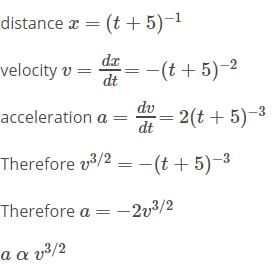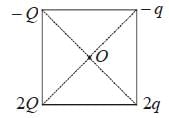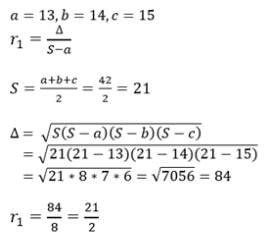Indian Air Force Agniveer Science & Other than Science Mock Test - 8 - Indian Air Force Agniveer Vayu MCQ
30 Questions MCQ Test - Indian Air Force Agniveer Science & Other than Science Mock Test - 8
A particle moves a distance x in time t according to equation x = (t + 5)-1. The acceleration of particle is proportional to [2010]
A body under the action of a force  acquiring an acceleration of 5ms−2. The mass of the body is
acquiring an acceleration of 5ms−2. The mass of the body is
 acquiring an acceleration of 5ms−2. The mass of the body is
acquiring an acceleration of 5ms−2. The mass of the body is A solid cylinder of mass 3 kg is rolling on a horizontal surface with velocity 4 ms–1. It collides with a horizontal spring of force constant 200 Nm–1 . The maximum compression produced in the spring will be : [2012]
Rotational analogue of force is :
A body is said to be perfectly elastic if
Internal energy of a system increases by 60 J when 140 Jof heat is added to the gaseous system. The amount of work done would be:
Four point charges –Q, –q, 2q and 2Q are placed, one at each corner of the square. The relation between Q and q for which the potential at the centre of the square is zero is : [2012]
Polarity of the capacitor in the situation described by the adjacent figure is

When light undergoes refraction, its frequency
In Geiger-Marsden experiment very small deflection of the beam was expected because
Which of the following statements is true fornuclear forces? [1990]
In a triangle ABC, a = 13, b = 14, c = 15, then r1 =
If k be a integer, then  is equal to
is equal to
The stone projected vertically upwards moves under the action of gravity alone and its motion is described by x = 49 t – 4.9 t2 . It is at a maximum height when
The area bounded by the curve y = 2x - x2 and the line x + y = 0 is
The probability that a card drawn at random from a pack of 52 cards is a king or a heart is
Find out the Synonym of the following word:
RECKLESS
Sixty miles / are / a good distance / No error.
Directions: In the given statements, a blank has been given. This needs to be filled up using the correct combination of words from the three options mentioned, so that the resulting statement is grammatically and contextually correct.
You should not _______________ the streets with rubbish; you should treat the public space the same way you would treat your own home.
I. garbage
II. loiter
III. litter
Which one best expresses the given sentence in Passive/Active Voice?
Has someone made all the necessary arrangements?
Direction: The sentences given in the question, when properly sequenced, form a coherent paragraph. Each sentence is labeled with a letter. Choose the most logical order of sentences from the given choices to construct a coherent paragraph.
A. As people turned to farming, they began to live in fixed settlements, which became small towns.
B. Their labors bore fruit; surplus food freed some of the population from farming.
C. In about 5000 BC, farmers moved down into the fertile river valleys of Mesopotamia, and built dykes and ditches to irrigate the arid land.
D. The cultivation of plants, such as wheat and barley, and the domestication of animals, such as sheep, goats and cattle, began in the Near East in about 8500 BC.
Directions: Read the following passage carefully and answer the questions given beside.
Remote sensing and GIS are promising tools for handling spatial and temporal data and help in integrating them for successful planning of natural resources. It is the science of measuring the earth using sensors mounted on high-flying aircrafts or satellites. These sensors collect data in the form of images and provide insights for manipulating, analysing and visualising those images. Since natural resources are not uniformly distributed and are spatially varied, it is challenging to capture the correct picture. Management of natural resources calls for scientific tools for timely and accurate dissemination of information. In natural resource management, remote sensing and GIS are mainly used in the mapping process. These techniques are useful in management of land, soil, coastal, watershed, urban and many more.
In India, the agriculture sector alone sustains the livelihood of around 50 percent of the population. Therefore, an increase in crop productivity has been a major concern. Since, the scope for increasing area under agriculture is limited, advanced crop production forecasting is required for better policymaking. Indian Space Research Agency (ISRO) and Indian Council of Agricultural Research (ICAR) successful experiment-Agricultural Resource Inventory and Survey Experiment (ARISE) used aerial colour photographs to estimate crop acreage in many states of India. Other Important uses of remote sensing include crop identification, stress detection, and crop yield modelling, drought monitoring, land degradation mapping and more. Urbanisation is important and inevitable for development, but its proper planning and management is crucial for sustenance. One of the important features of GIS is multilayered mapping. This kind of mapping helps municipal corporations, town planning boards to build cities that are better organised. The information systems with socio-economic data overlaid upon satellite data makes urban planning cost-effective and accurate.
Coastal ecosystems have high ecological significance. GIS and remote sensing data are used to study coastal ecosystems and marine living resources which include habitats like mangroves, coral reefs and more. Apart from this, suspended shoreline dynamics can be studied and climatic changes leading to cyclones and sea level rise may be of special interest too. Geospatial data is effective in the analysis and determination of factors that affect the utilisation of these resources. The technologies provide a platform through which we can generate information that can be used to make sound decisions for sustainable development of the natural resources of India.
Q. What can be the most appropriate title for the passage?
What name is the elected representative who are not the members of the ruling party
In the context of the Indian freedom struggle, 16th October 1905 is well known for which one of the following reasons?
Find the last number which when divided by 6, 8, 15 and 30 leaves remainder 2, 4, 11 and 26 respectively?
If A + B means A is the brother of B; A x B means A is the son of B; and A % B means B is the daughter of A then which of the following means M is the maternal uncle of N?
What is Milindapanho'?-
What was the purpose of the Maritime Partnership Exercise (MPX) conducted by India and France in the Bay of Bengal?
DEER = 12215 and HIGH = 5654, how will you code HEEL?



 and a = 5ms−2
and a = 5ms−2




















